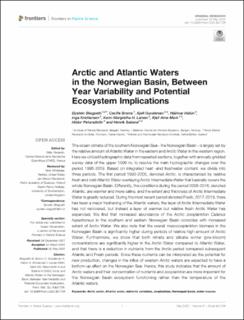| dc.description.abstract | The ocean climate of the southern Norwegian Sea - the Norwegian Basin - is largely set by the relative amount of Atlantic Water in the eastern and Arctic Water in the western region. Here we utilized hydrographic data from repeated sections, together with annually gridded survey data of the upper 1000 m, to resolve the main hydrographic changes over the period 1995-2019. Based on integrated heat -and freshwater content, we divide into three periods. The first period 1995-2005, denoted Arctic, is characterized by relative fresh and cold Atlantic Water overlaying Arctic Intermediate Water that basically covers the whole Norwegian Basin. Differently, the conditions during the period 2006-2016, denoted Atlantic, are warmer and more saline, and the extent and thickness of Arctic Intermediate Water is greatly reduced. During the most recent period denoted Fresh, 2017-2019, there has been a major freshening of the Atlantic waters, the layer of Arctic Intermediate Water has not recovered, but instead a layer of warmer but relative fresh Arctic Water has expanded. We find that increased abundance of the Arctic zooplankton Calanus hyperboreus in the southern and eastern Norwegian Basin coincides with increased extent of Arctic Water. We also note that the overall mesozooplankton biomass in the Norwegian Basin is significantly higher during periods of relative high amount of Arctic Water. Furthermore, we show that both nitrate and silicate winter (pre-bloom) concentrations are significantly higher in the Arctic Water compared to Atlantic Water, and that there is a reduction in nutrients from the Arctic period compared subsequent Atlantic and Fresh periods. Since these nutrients can be interpreted as the potential for new production, changes in the influx of western Arctic waters are expected to have a bottom-up effect on the Norwegian Sea. Hence, this study indicates that the amount of Arctic waters and their concentration of nutrients and zooplankton are more important for the Norwegian Basin ecosystem functioning rather than the temperature of the Atlantic waters. | en_US |
